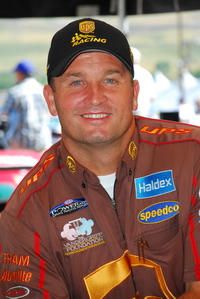VANDERGRIFF: “WE’VE DIVERTED FROM REAL REASON FOR 1,000 FEET”

Racing to the thousand foot mark, in his opinion, is hurting the sport. He’s read the articles and watched the interviews on television and it’s become evident to him that those who this affects the most are off course.
“I think we have lost sight of why we went to 1,000 feet,” Vandergriff said. “The biggest gripe I have with people praising 1,000 feet is hearing people talk about we are saving money and the downside to that is that was never the intention for going to 1,000 feet. We didn’t worry about how much money we were spending before. It makes me sick to my stomach when
I hear someone talking about how much money we are saving by racing to 1,000 feet.
Top Fuel Veteran Feels 1,000 Foot Racing Hurts Drag Racing …
Bob Vandergriff Jr. is as much a drag racing purist as the next driver
or drag racing fan, but that has no bearing on his desire to return
nitro racing to the traditional quarter-mile race course.
Racing to the thousand foot mark, in his opinion, is hurting the sport.
He’s read the articles and watched the interviews on television and
it’s become evident to him that those who this affects the most are off
course.
“I think we have lost sight of why we went to 1,000 feet,” Vandergriff
said. “The biggest gripe I have with people praising 1,000 feet is
hearing people talk about we are saving money and the downside to that
is that was never the intention for going to 1,000 feet. We didn’t
worry about how much money we were spending before. It makes me sick to
my stomach when

I hear someone talking about how much money we are saving by racing to 1,000 feet.
I understand they are giving me an extra 320 feet. The reality is that I am still going over 315 miles per hour. The reality is that you need to give me a better facility to get my butt stopped.
“I think we are standing on the wrong soapbox and praising it for the wrong reasons.”
Besides what he feels is the monetary misinformation, Vandergriff
is quick to point out the same safety issues still remain unresolved
and wonders when certain issues predating the Scott Kalitta accident
are going to be resolved.
“The NHRA has gone to some lengths to repair the shutdown areas at some
tracks because of that tragedy and I commend them for their efforts,”
Vandergriff said. “But, it hasn’t been a universal scenario. We come
from Charlotte where we had one of the shutdown areas like Indy did but
then we go to Dallas where they trumpet the fact Billy has spent all of
this money in the shutdown area but at the same point we have light
poles hanging off the wall. Scoreboards still haven’t been moved, they
are still too close to the track twenty years later. I think we are
looking at one thing and still overlooking a lot of things as far as
the reason we went to 1,000 feet.
“I think that’s what we need to be saying instead of standing up there saying how much money we are saving.”
a d v e r t i s e m e n t
Click to visit our sponsor's website
Yes there is the contention that the racing is closer than
ever, but Vandergriff feels this may be one of the few positive
byproducts. The cars are still blowing up and leaving just as much oil
on the racing surface.
“The close racing is good, but I don’t think we are seeing any less
blow ups than we did before. I think you are seeing the teams turning
up the wick because they only have to go to 1,000 feet. That was the
one thing I was concerned about from the get-go. I figured then people
would stop worrying about the car having to make it to the [traditional
quarter-mile] finish line. That last few races, we’ve seen some pretty
catastrophic blow-ups. With that comes a lot of downtime with the oil
downs. I think this kind of throws the saving thing right out the
window. We might get some extra runs on certain parts but that will
eventually go away because these teams have the engines only tuned to
run 1,000 feet now.
“Where we used to start hurting the engine at 800 – 900 feet, we used
to shut off early because we had another 400 – 500 feet to go, but now
that we are going to 1,000, we don’t do that because we only have to go
another 100 or so. Besides the majority of the drivers out there are
still driving them to the [traditional] finish line anyway.”
He’s heard all of the talk of slowing the cars down through adjusting
certain areas of the engines, such as compression ratio and other
ideas, but he’s convinced those, while looking good on paper and in the
justification process, will be futile in the end.
a d v e r t i s e m e n t
Click to visit our sponsor's website
In other words, Vandergriff understands the cars may slow
temporarily but the tuners will find a way to make them go fast again.
He wonders when those in charge are going to finally realize the
problem is not in the cars, the problem largely remains with the
facilities.
“The reality of it is they can’t reduce it enough that it’s going to
matter,” Vandergriff said. “You’re still going to be traveling at over
300 miles per hour. The bottom line is that you need to improve the
facilities because they can’t slow me down enough that it’s going to
matter.
“I understand they are giving me an extra 320 feet. The reality is that
I am still going over 315 miles per hour. The reality is that you need
to give me a better facility to get my butt stopped. You can’t change
the horsepower of these cars enough that it’s going to matter. We have
alcohol cars in the sand-trap at 260 miles per hour. I think our focus
is in the wrong area because you can’t slow us down enough even if we
are running to 1,000.
“Scott Kalitta’s car blew up at 1,000 feet. How does that change
anything? Racing to 1,000 feet he still would have blown up. The bottom
line is we are still running 300 to 1,000 feet, so we need the
facilities to give us an opportunity to walk away from these things.”
a d v e r t i s e m e n t
Click to visit our sponsor's website
Vandergriff points out that while some of his fellow competitors
are praising the 1,000 feet for cost efficiency, many of them are
missing a key element.
In the midst of a worldwide economic crisis, Vandergriff wonders if
many realize that by cutting the 320 feet from the track could be the
difference in selling and not selling the sport to ad agencies
unfamiliar with the merits of drag racing.
Vandergriff will be among many Top Fuel drivers sitting on the
sidelines in 2009 without a major sponsor. Next season figures to be a
lean venture for the kings of the sport with as few as eight full time
teams committed to the entire 24-race Full Throttle NHRA Drag Racing
Series.
“As a person who tries to sell drag racing on a daily basis, and speaks
with a lot of agencies and companies on behalf of drag racing, the one
thing we overlook is that it’s hard enough to sell the sport because it
doesn’t translate well into television, but when you get a novice
agency person who doesn’t have any idea what drag racing is and you try
to convince them our sport is the greatest in the world yet the races
last less than five seconds,” Vandergriff continued. “Now the problem
we have is that we have to sell based on the fact our races last less
than four seconds. We are reducing the product we are selling. When you
are racing for NASCAR and other forms of motorsports where their races
last for hours, the hardest thing to sell is how cool our races are
when they last less than four seconds. That’s hard to do.”
“Any time you diminish the product you are selling, it becomes harder to sell.”
Given the state of the economy, Vandergriff would rather have the
dollars to race to 1320 feet, because when he's not racing, he's not
saving any dollars on parts; he's risking going out of business.
| {loadposition feedback} |





